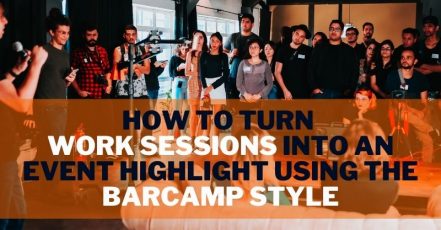Workshop sequences are often an important program item at business events, as they turn passive visitors into active participants. Hands-on work sessions are primarily used for (more) visitor activation and networking, but they become a real "event highlight" when a pressing problem is solved.
There are countless workshop formats, from simple brainstorming to elaborate design thinking sessions. But there are also small, creative workshop formats that can be used to inspire the participants.
One example is a workshop format using the so-called "Barcamp-style". A Barcamp is actually an event format where there is no fixed running order, but a flexible agenda created by the participants themselves (on-site or in advance of the event). Participants are asked to submit proposals for workshop topics, which are then selected by voting. The topics selected by the majority are the topics of several work sessions. The participant whose topic was selected for a work session is the moderator of it. The goal of each Work Session is to exchange opinions and (if applicable) develop ideas and solutions.
A "Barcamp" (in its original form) is particularly suitable for large events with hundreds of participants. In a slightly modified form, the core idea of the methodology can also be used for smaller business events (corporate events, company events, conferences, business meetings, etc.). However, the group of visitors must not be too small, otherwise the necessary dynamics in the work groups will not arise. As a rule of thumb, the minimum number of participants is 24, divided into at least 4 working groups, each working on a relevant problem or task.
The original Barcamp format should not (and cannot) be explained here, as this would go beyond the scope of this "Quick Training". That’s why in this micro-training, we’ll limit ourselves to the process of a Work Session in a "Barcamp-style".
Here’s how to plan a Barcamp-style Work Session at a Business Event:
- The event organizer defines a main topic that is currently urgent or very relevant for the visitor target group (e.g., "The Sustainable Office," "The Sustainable Factory," "The Agile Company," "Creative Approaches in Personnel Recruiting," etc.).
- From among the participants (in the run-up phase of the event), tasks or problems related to this main topic are collected; 4 – x working groups are formed (depending on the total number of participants); the assignment of the participants to the working groups is done either randomly or according to individual interests
- The participants who have proposed a task/problem are asked to explain their personal preferred solution to the participants of their working group; the group work is conducted in several rounds, each round is limited to 15-30 minutes
- Round 1: Explanation of the problem and presentation of the proposed solution by the proposer (= workshop leader).
- Round 2: The participants initially only ask questions of understanding; evaluations or personal opinions on the presented solution are not desired in round 2.
- Round 3: Now each participant makes a personal statement about the solution; as a rule, only constructive contributions are welcome, i.e. support for the proposal or constructive criticism in the form of suggestions for improvements or additions.
- Round 4: The proposer defines the optimal solution in mutual exchange with the group; the result is a final proposal that is considered good/feasible by all participants.
- Round 5: The final proposal is recorded on a flipchart or in a mini-presentation and presented to the entire plenum (= all event participants) in a final closing sequence.
Well prepared, such a "Barcamp-like" workshop format can be a real event highlight. The benefits, especially in the context of business events, are obvious:
1) Not the organizer, but the participants determine the agenda (more visitor integration and visitor orientation is not possible).
2) A current topic (= main topic of the event), which is important/relevant for all participants, is analyzed from different perspectives.
3) The participant who has proposed a topic to work on can obtain different opinions on his/her proposed solution; he/she thus gains new impulses in a stress-free, constructive/positive working atmosphere.
4) The participants who actively participate in the working groups also gain new insights; they benefit from the fact that someone else has already thought about a possible/optimal solution and still have the chance to add their own ideas.
5) In addition, all participants benefit from the format beyond their own working group when the results of all (other) working groups are presented in a grand closing sequence.
6) Due to the less "frontal", strongly interactive character, the entire event becomes lively, each participant gets to know new people and can strengthen his/her network.
7) This workshop format is also possible in a tight time frame (e.g. 1.5 hours) and thus leaves plenty of room for additional event highlights, e.g. an inspiring impulse lecture preceding the work sessions, expert talks, entertaining agenda items, etc.
Author (Copyrights): eventmasterbook.de editorial team, Nov. 30th 2021 (Cover photo / Collage: eventmasterbook.de editorial team)
Related topics:
Event management, event planning, business events, corporate events, company events, networking events, visitor integration, visitor activation, barcamp, workshop, work session, workshop methods, workshop moderation, visitor engagement, visitor involvement, interactive methods, event highlights, event planning, program planning, agenda, running order, networking.
(This text was translated from the German language. Please excuse any errors.)
Categories:








